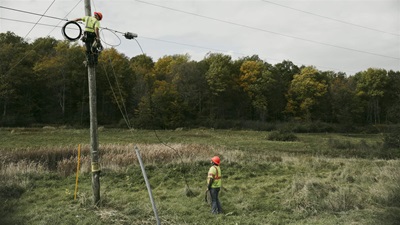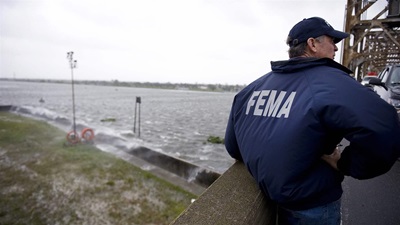States Consider Effects of Rising Federal Tariffs
Uncertainty looms nationwide, but states with deep ties to manufacturing and global trade are most exposed
When the federal government imposes tariffs on imports, the effects often ripple far beyond cargo ships and customs offices. Tariffs have the potential to significantly influence state budgets by increasing uncertainty in economic forecasts, raising the costs of public projects, and disrupting revenue streams.
After the federal government’s implementation of sweeping new and expanded tariffs this year, state policymakers are watching how these dynamics might play out, especially for states with strong manufacturing bases and major coastal ports. A Pew Charitable Trusts analysis found that manufacturing-intensive states—such as Indiana, Kentucky, Michigan, and Tennessee—and those with deep ties to global trade—for example, Georgia, New Jersey, South Carolina, and Texas—are among the most vulnerable to potential fiscal disruptions linked to increased import costs.
While all states face some degree of fiscal disruption from increased tariffs, any resulting effects will take time to surface in state budget data. However the uncertainty alone can be enough to affect economic behaviors and prompt consumers to become more cautious; slow spending; and cause businesses to delay investments. Many states are proactively lowering their revenue forecasts to account for any tariff-related uncertainties and other mounting fiscal and economic disruptions. Policymakers are also refining their financial management strategies to mitigate any potential impact.
Manufacturing- and trade-heavy states most vulnerable
Every state faces fiscal disruptions from tariffs on imported goods, but not all will feel the pressure equally. The exposure of a state’s finances can vary dramatically depending on how heavily the state relies on imported goods relative to its total economy (measured by gross domestic product, or GDP), how much each state purchases in tariffed goods, and how dependent it is on tax revenues that are sensitive to shifts in consumer spending.
In 2024, the U.S. imported $3.3 trillion worth of goods, representing 11.2% of national GDP—though that figure varied widely across the states. Imports exceeded 20% of state GDP in Indiana, Kentucky, Michigan, and Tennessee but accounted for less than 3% in Hawaii, South Dakota, Wyoming, and the District of Columbia. Imports from China alone—second only to Mexico in imports to the U.S.—totaled $439 billion, or 1.5% of national GDP, and ranged from a high of 3% or more in California, Illinois, and Tennessee to a low of 0.1% in Alaska and Montana.
The top U.S. imports by dollar value—and therefore those most exposed to increased tariffs—include computers, vehicles, pharmaceuticals, machinery, and electrical equipment. Goods from China are especially relevant, because its products have faced some of the steepest U.S. tariffs and drawn some of the most extensive retaliatory measures, such as new tariffs and other trade barriers imposed in response. Top imports from China included communications equipment such as cellphones; electrical equipment such as certain batteries; manufactured goods such as jewelry, sporting goods, or toys; general purpose manufacturing machinery; and fabricated metal products such as cookware and cutlery.
States with economies anchored in manufacturing that rely heavily on the use of imported materials and parts, particularly in the automotive and metals industries across the Great Lakes and Southeast, face heightened financial uncertainties. Tariffs could significantly inflate production costs and disrupt local economies in Kentucky (where imports make up 32.3% of GDP), Michigan (24.5%), Tennessee (21.9%), Indiana (20.2%), Illinois (19.2%), Mississippi (13.6%), and Alabama (12.1%).
Meanwhile, states with large coastal ports—such as New Jersey (where imports make up 18.1% of GDP), South Carolina (16.6%), Georgia (16.5%), Texas (14.7%), and California (12.0%)—may also feel tariff pressures directly through shifting shipping volumes and logistics disruptions.
Agricultural and energy states stand somewhat apart with relatively lower reliance on imported goods. For these states, the bigger threat comes from retaliatory tariffs affecting their export-driven economies, rather than the immediate effects of higher import costs. Louisiana is a clear example: Exports made up 26.5% of its GDP in 2024—the highest share of any state—with energy and chemicals among those most vulnerable to potential retaliatory tariffs. Meanwhile, Iowa, a top agricultural state, relied on exports for 6.6% of its GDP, driven by meats, grains, and farm equipment.
Tariffs haven’t hit state budgets—yet
Although the risk of higher import costs is real, most states have not yet seen measurable increases directly tied to tariffs. That’s partly because state spending is often guided by long-term contracts that renew at different intervals, delaying immediate effects.
“Most large state procurement contracts are annual, so it may take another fiscal year for any price increases to appear,” explained Jerry McGinty, director of Texas’ Legislative Budget Board. “Right now, it’s too early to tell.”
Typical examples of state contracted spending include construction materials for infrastructure, vehicle fleets for public agencies, and equipment for schools and hospitals.
Tariffs don’t just affect state costs, though; they also influence revenues indirectly through economic behavior. Higher prices can dampen consumer spending and business investment, resulting in lower state tax revenues. Additionally, retaliatory tariffs from U.S. trading partners could reduce demand for exports.
Overall, businesses bear the cost of tariffs initially. According to an analysis of U.S. Treasury data by the Bipartisan Policy Center, the federal government collected approximately $190 billion in tariff and other excise taxes in the first nine months of 2025 alone—more than double the amount collected during the same period in 2024. Manufacturers, importers, and wholesalers, for example, pay these taxes, yet how quickly—and how fully—they pass the costs on to consumers remains unclear.
Notably, although tariffs have added cost pressure to some materials and imports, consumer price growth has not accelerated dramatically. After peaking in 2022, the overall inflation rate slowed to within a percentage point above the Federal Reserve’s 2% target in mid-2024 and, despite consecutive monthly increases in May through August this year, has remained relatively stable within that range. Many businesses may have stocked up on inventories ahead of the tariff rollout, which would allow companies to temporarily shield customers—and themselves—from rising costs. But that buffer may be eroding: The producer price index for goods rose steadily from May through August 2025, according to the Bureau of Labor Statistics, suggesting that upstream cost pressures in goods may filter through to consumers in the months ahead.
The impact of tariffs can also play out differently across states. For instance, Louisiana’s experience could unfold more slowly than that of others. “We’re really in wait-and-see mode,” said Alan Boxberger of the Louisiana Legislative Fiscal Office. “Louisiana typically lags behind national trends by 18 to 24 months, so if historical precedent holds, any impact from tariffs or recession would likely show up here later.”
States must manage the risks
“When we were putting together our final budget projections in May, there really wasn’t anything in the real-time data—jobs, consumer spending—capturing a meaningful effect from the tariffs,” said Brian Uhler of California’s Legislative Analyst’s Office. “But that doesn’t mean there’s no effect.”
Uhler, a deputy state analyst, described tariffs as a “known unknown,” underscoring the uncertainty and wide range of potential outcomes that complicate budget forecasting.
Surveys conducted by the University of Michigan show that tariffs—and the expectation that they’ll lead to higher prices—have become a top concern for consumers, probably contributing to a more cautious spending environment. Although this caution could translate into slower sales tax growth, it could also lead to short-term volatility. Texas experienced this firsthand.
“Motor vehicle sales tax revenue spiked 35% in March when compared to the same month a year ago,” McGinty said, referring to state data collected by the Texas Legislative Budget Board. “In news reports at the time, auto dealers said customers may have been rushing to buy before the auto tariffs took effect.”
That cautionary consumer behavior may also be showing up in the national data. Inflation-adjusted consumer spending slowed in the first and second quarters of 2025 following robust growth at the end of 2024. For states that rely heavily on sales and use taxes, even modest pullbacks in real spending can affect their revenue performance.
Many states have proactively begun factoring economic uncertainty—including tariffs—into their revenue projections. At least half of the states recently revised down their expectations for fiscal 2026, according to a Pew analysis of state budget documents. In Michigan, officials lowered revenue projections by $320 million after forecasting weaker economic conditions, including the potential loss of about 3,300 auto sector jobs over the next three to five years because of tariff-related cost pressures.
During past periods of significant price uncertainties, some states chose to delay, redesign, or cancel infrastructure projects, in part because of higher costs but also because of difficulties in confidently estimating future prices for essential materials, such as steel, aluminum, and lumber.
Furthermore, state finance officers may restructure bond issuances to reflect changing cost expectations, increasing complexity and potentially delaying funding. Price uncertainty frequently causes underwriters to demand more contingency funds, financed alongside the project costs, resulting in some states needing to borrow more up front or to downsize projects.
Certain states, including California, are enhancing data tracking and budget modeling efforts to capture and respond to tariff impacts more effectively. “We’ve shifted some of the data we’re providing legislators, such as new car registrations and inflation indicators, to better monitor real-time economic impacts,” Uhler said.
Final thoughts
Whether the recent wave of tariffs marks a temporary shift in federal policy or the beginning of a lasting new normal remains unclear. But for now, state governments are adapting to a world of heightened economic and policy uncertainty.
One complicating factor: There’s relatively little historical precedent for what happens when the U.S. erects broad-based trade barriers in such a short period of time. Although manufacturers, importers, and wholesalers are paying the new and expanded tariffs now, it remains unclear how quickly—and how fully—the added costs will be passed on to consumers through higher prices, and how that will affect state tax revenues and spending.
The fiscal impacts will vary by state, but all policymakers will need to plan amid uncertainty. With limited ability to influence federal trade decisions, state officials are focused on controlling what they can—monitoring costs, protecting budget flexibility, and preparing for multiple possible futures.
Justin Theal is a senior officer and Joanna Biernacka-Lievestro is a former senior manager with The Pew Charitable Trusts’ state fiscal policy project.











